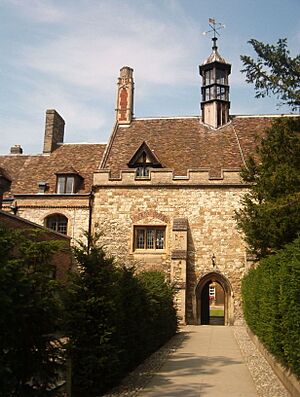Shallet Turner facts for kids
Shallet Turner (born around 1692 – died November 13, 1762) was a smart person who became a Fellow at Peterhouse, Cambridge, which is a college at the famous University of Cambridge. He was also a Fellow of the Royal Society, which means he was part of a very important group for science and learning.
Turner became a professor of history at Cambridge, but he was known for treating this job like a "sinecure". This means he got paid for the job but didn't do much work!
Contents
Early Life and Education
Shallet Turner was born in a place called Tynemouth in England. He was baptized, which is a type of church ceremony, on September 27, 1692. He went to school in Houghton-le-Spring when he was young.
When he was 17, in 1710, he started studying at Peterhouse, Cambridge. He was a "pensioner," which meant he paid for his own studies. Later that year, he became a "Cosin Scholar," which might have meant he got some financial help.
He worked hard and earned his first degree, a Bachelor of Arts (BA), in 1713 or 1714. He then became a fellow of Peterhouse in 1715. This meant he was a senior member of the college. He continued his studies, getting a Master of Arts (MA) in 1717 and a Doctor of Laws (LL.D.) in 1728. He also became a "Junior Dean" at his college, which is a leadership role. Turner was especially interested in Mathematics.
Becoming a Professor
In 1724, King George I created new professor jobs at both Oxford and Cambridge universities. These jobs were for "Modern History and Modern Languages." The professors were supposed to be good at history and languages. They would earn a good salary of £400 a year.
However, these jobs often became "sinecures." This meant the King could give the job to someone he liked, and that person didn't have to do much work.
In 1735, Shallet Turner was chosen to be the new Regius Professor of Modern History at Cambridge. The person who wrote the History of the University of Cambridge said that Turner had "no qualifications whatever" for the job, except that he was already a fellow at Peterhouse.
What Did He Do as Professor?
After Turner became a professor, a government worker asked him about his duties. Turner replied that he hadn't made a list of King's Scholars in over seven years. He also said that all the places were empty and that the paperwork was with the Secretary of State. Nothing was done about this.
In 1737, a famous writer named Thomas Gray wrote a letter to his friend Horace Walpole. Gray was being sarcastic when he wrote that Professor Turner was planning to go to Paris every year, even with all his important duties. This shows that people knew Turner wasn't taking his job seriously.
Turner kept his professor job from 1735 until he died in 1762. That's 27 years! A historian of the university later wrote that "Turner held the professorship for seven and twenty years and did absolutely nothing."
Another person named William Cole, who collected old things, wrote about Turner. He said Turner never lived at the university. He only visited his friend, Dr. Smith, at Trinity College. Cole also said that Turner never thought he needed to give lectures. Instead, he paid a small amount of money to the teachers of French and Italian at the university. One of these teachers, Signor Piazza, often complained that Turner didn't pay him much.
Other Activities
On March 26, 1741, Turner was elected a Fellow of the Royal Society. This was a big honor, showing he was respected in the world of learning, even if he wasn't very active as a professor.
In 1748, Turner helped support the publication of a book by Colin Maclaurin about Isaac Newton's discoveries. That same year, Turner left his fellowship at Peterhouse.
In 1751, a pamphlet (a small book) was published that complained about problems at the university. It said that if the Professor of Modern History actually lived at the university and had helpers, many students would come to his useful lectures. But the king and the government didn't do anything about these complaints.
Turner also supported other books. In 1750, he helped with Archibald Bower's The History of the Popes. In 1759, he supported a new translation of The Tragedies of Sophocles by Thomas Francklin, who was another professor at the university.
His Legacy
Sir Edmund Gosse, who wrote about Thomas Gray, said that the professor job Turner held was seen as a complete sinecure. This means everyone knew it was a job where you didn't have to do any work.
After Turner died in 1762, Thomas Gray's friends tried to get him the same professor job. They knew that "no lectures should be given." In fact, no lectures were given until after Gray himself died! Gray didn't get the job right away, but he did get it later in 1768.
Shallet Turner's will, which is a legal document about what happens to his money and belongings after he dies, was handled in a special court called the Prerogative Court of Canterbury.
A historian named Wallace Brockway wrote about Shallet Turner in 1955. He said that Turner, who was a professor for more than 25 years, was just "a footnote, and an uninteresting one." This shows that Turner wasn't remembered for doing much during his time as a professor.


